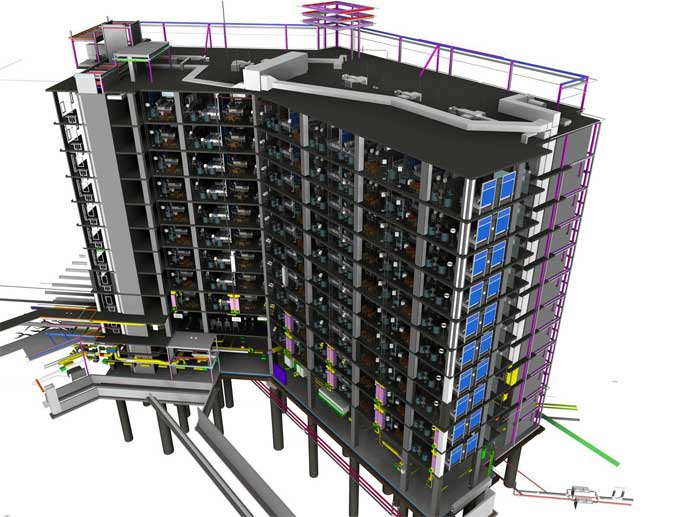BIM is no longer just a 3d model; it contains much more
Tweet
An architectural BIM is more than just software or a simple 3D model. Among its contents, there are not only the model components but also the tremendous amount of information and the process of exchanging that data with other parties involved.
BIM workflows deliver a much more dynamic and synchronized approach to project management compared to previous workflows that relied on multiple formats and disconnected processes.
Architects, designers, engineers, contractors, owners and clients, all benefit from BIM. Building information modeling (BIM) involves processes, technologies, and people to manage data and information throughout a facility's life. Now owners can make confident decisions based on their ability to see into the future.
Define BIM
BIM is the link between people, technology and processes to improve outcome in building and construction. Using a single cohesive system of 3D models rather than separate designs, it describes the process of designing, building, and operating a building collaboratively. Using BIM, skyscrapers, hospitals, office buildings, and residential buildings can be built more efficiently and on time while reducing costs.
Importance of BIM
A BIM workflow that dynamically connects design, analysis, and documentation allows project effort to shift back into the detailed design phase - where the possibility of impacting project performance is high. As a result, engineers spend more time evaluating what-if scenarios, thereby reducing construction documentation, and less time generating construction documents.
The Reason behind BIM is not just a 3D model
Understanding Client?s Building
The scale provided by a BIM allows clients to experience the building before renovation begins. BIM increases energy efficiency by predicting consumption, light usage, and similar factors.
Process not a Tool
It is true that there is a learning curve to realize the benefits of BIM, but there is also a lot of available training that can facilitate implementation, even for the busiest architects and engineers.
Works in Multiple Model
An integrated BIM system is not a centralized model, but rather a collection of models and databases linked together. As a result, every stakeholder can be the owner of his or her model and discipline, which allows flexibility in how alterations can be made.
Design Improvement
By visualizing the finished product, we can come up with more effective and elegant designs. Using BIM, design and contract documents can be coordinated across disciplines, further enhancing the finished design.
Improve Efficiency
Over time, BIM can produce productivity gains that outweigh the initial training time loss. It is vital that BIM for the construction industry becomes Business As Usual for companies seeking competitive advantage, reducing expenses, improving data accuracy, reducing duplicate work and working more efficiently.
Does not matter in Project?s Size
Any organization, no matter how large or small, can use BIM to make smarter decisions and improve the quality and efficiency of projects. Documentation is automatically updated every time a change is made.
Mindset
BIM isn't just software; it's more of a process. Processes must be reengineered to incorporate people, methods, and technology effectively in a collaborative digital paradigm to fully utilize BIM.
To get online demonstration, watch the following video tutorial.
Video Source: Balkan Architect
Wrapping it Up
It has always been considered a key for the engineering and construction sector in regards to how it can face some of the challenges inherent in the industry.
Even with all of this attention, BIM is still regarded as a 3D modeling tool, one that?s only for experts and used by a small fraction of the development teams. There are still some negative perceptions about institutionalizing BIM, despite BIM being widely accepted in the industry.

Gallery
Feel free to contact us for BIM requirements. One of our representative will respond you within 24 Hours. Send us your projects requirement today and grow your project.
Explore More !







